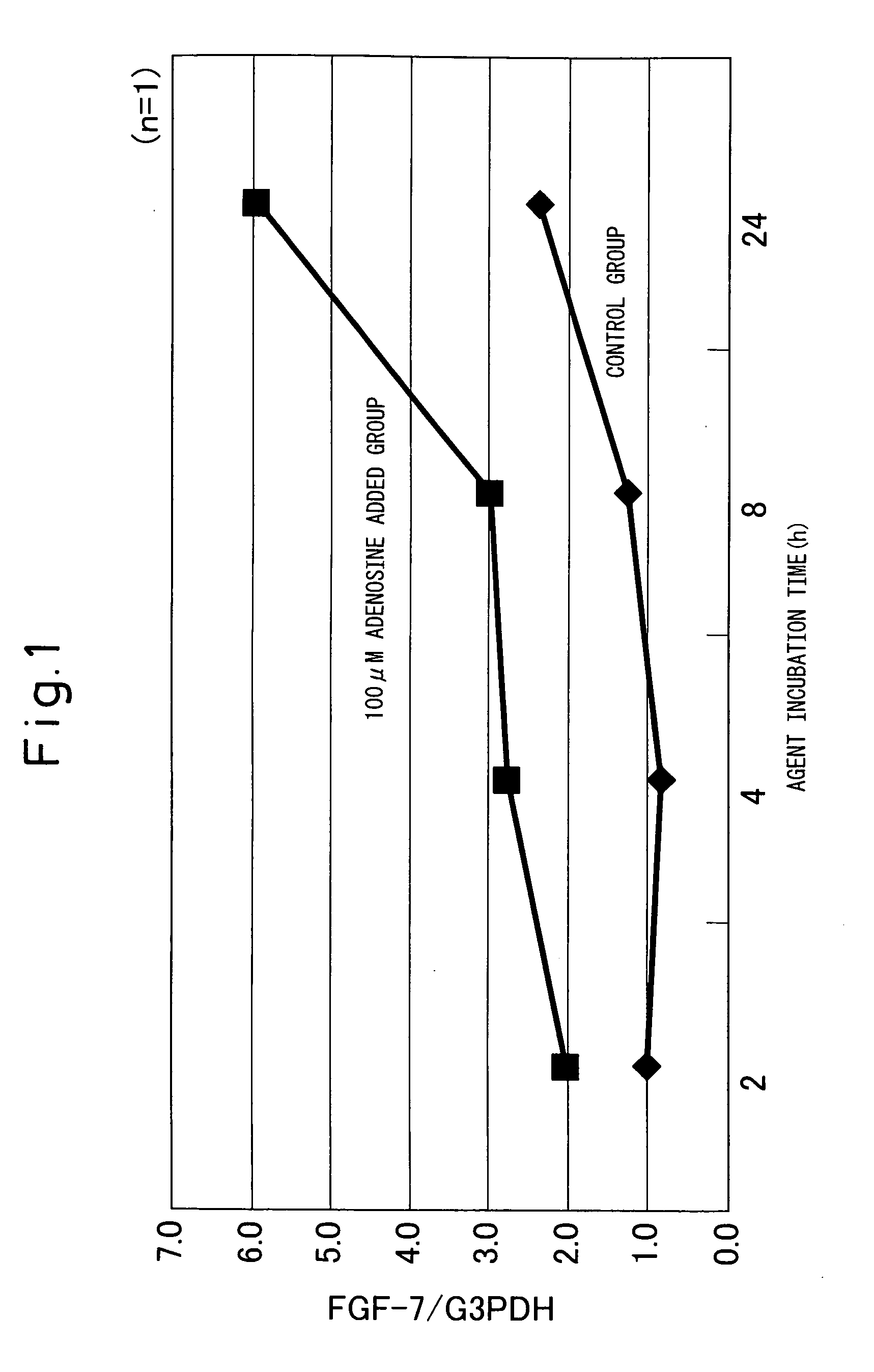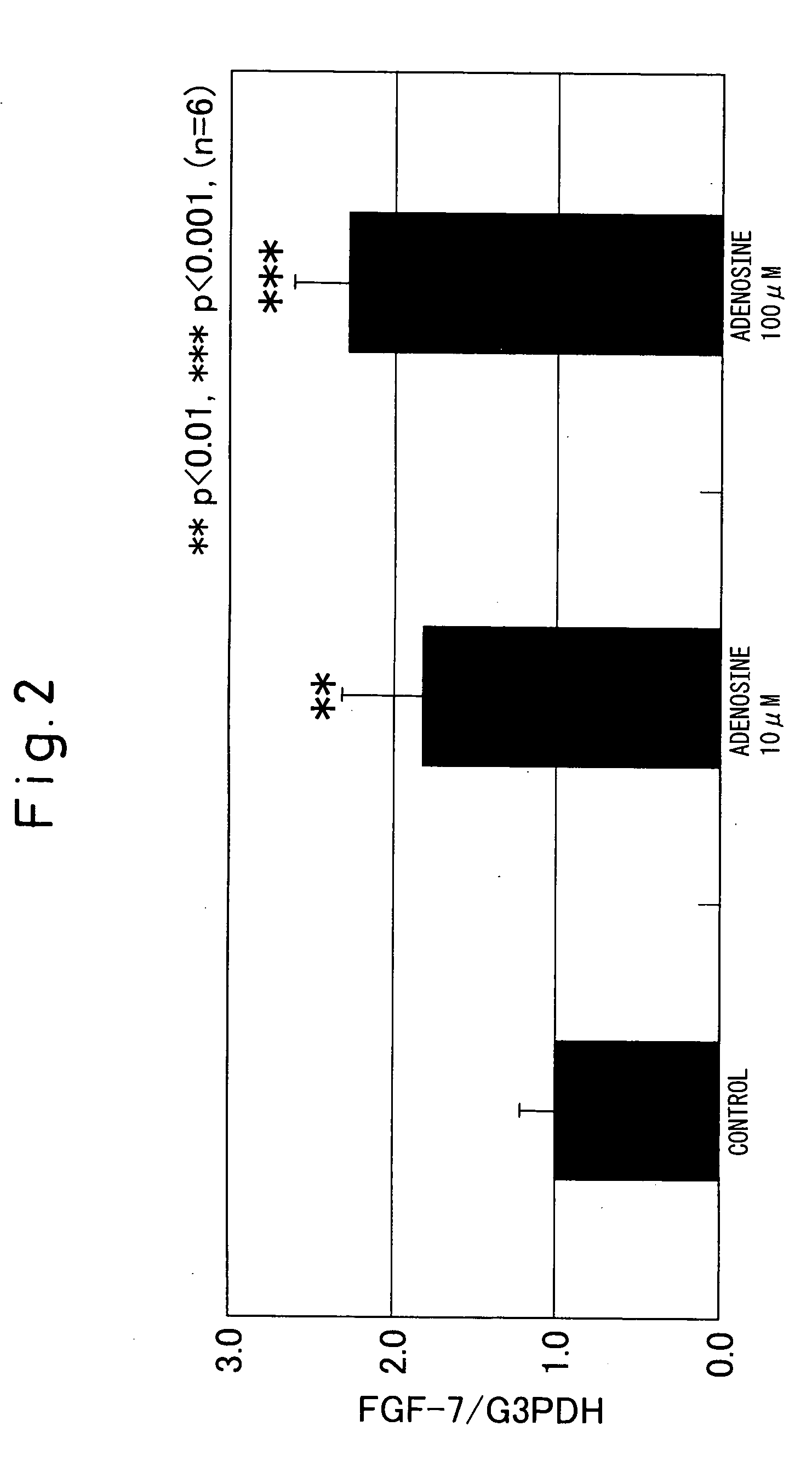Method and Composition for Thickening Hair
a hair thickening and composition technology, applied in the field can solve the problem that the role of fgf-7 in hair growth has yet to be determined, and achieve the effect of maintaining and promoting hair thickening, effective method and composition
- Summary
- Abstract
- Description
- Claims
- Application Information
AI Technical Summary
Benefits of technology
Problems solved by technology
Method used
Image
Examples
experiment 1
Study of Increased Expression of FGF-7 by a Quantitative PCR Experiment (1)
1) Cell Culture
[0050] The human dermal papilla cells (DPC) used in the experiment consisted of DPC originating in a 34 year old woman that were placed in frozen storage after being isolated and cultured from human scalp provided as a by-product of plastic surgery. The cells were disseminated to a cell density of 1.0 to 1.5×104 cells / cm2, and cultured in MEM (Gibco) containing 10% FBS under conditions of 37° C. and 5% CO2. The medium was replaced at the rate of twice per week, and the cells were harvested by separating from the dish with 0.25% trypsin when the cells had reached confluence (10 to 20 days after seeding) followed by disseminating again at a density of 1.0-1.5×104 cells / cm2.
2) Agent Treatment of Cultured Cells
[0051] After thawing and sub-culturing 1 to 3 times, the DPC were seeded into a 24-well plate at a density of 4.0×104 cells / well, and the medium was replaced 4 days later with MEM (seru...
experiment 2
Study of Increased Expression of FGF-7 by a Quantitative PCR Experiment (2)
[0054] An RT-PCR experiment was carried out in the same manner as Experiment 1 with the exception of using two concentrations of adenosine consisting of 10 μM and 100 μM and setting the duration of adenosine treatment to 3 hours. The results are shown in FIG. 2. As is clear from this figure, expression of FGF-7 in dermal papilla cells treated with adenosine was confirmed to increase dependent on the concentration of adenosine.
experiment 3-1
Study of Increased Expression of FGF-7 by a Quantitative PCR Experiment (3)
[0055] An RT-PCR experiment was carried out in the same manner as Experiment 1 with the exception of using the adenosine analogue CCPA (2-chloro-N6-cyclopentyladenosine) (100 μM), C1-IB-MECA (2-chloro-N6-(3-iodobenzyl)-9-[5-(methylcarbamoyl)-β-D-ribofuranosyl]adenine) (50 μM) or NECA (N-ethylcarboxyamidoadenosine) (10 μM) instead of adenosine, and setting the duration of agent treatment time to 3 hours. (Furthermore, in cases in which the solubility of the agent is low, all of the agent-containing media may be prepared to a DMSO concentration of 0.1%, including the agent-free control.)
[0056] The results are shown in FIG. 3. As is clear from this figure, expression of FGF-7 in dermal papilla cells treated with CCPA, C1-IB-MECA or NECA was observed to be significantly increased.
PUM
| Property | Measurement | Unit |
|---|---|---|
| diameter | aaaaa | aaaaa |
| diameter | aaaaa | aaaaa |
| diameter | aaaaa | aaaaa |
Abstract
Description
Claims
Application Information
 Login to View More
Login to View More - R&D
- Intellectual Property
- Life Sciences
- Materials
- Tech Scout
- Unparalleled Data Quality
- Higher Quality Content
- 60% Fewer Hallucinations
Browse by: Latest US Patents, China's latest patents, Technical Efficacy Thesaurus, Application Domain, Technology Topic, Popular Technical Reports.
© 2025 PatSnap. All rights reserved.Legal|Privacy policy|Modern Slavery Act Transparency Statement|Sitemap|About US| Contact US: help@patsnap.com



